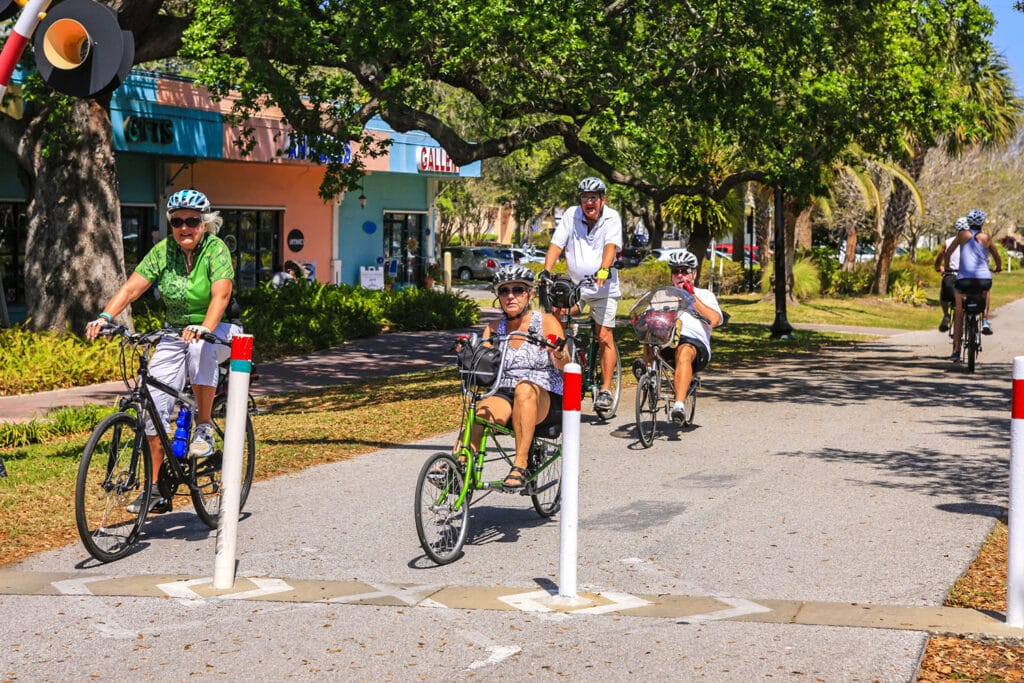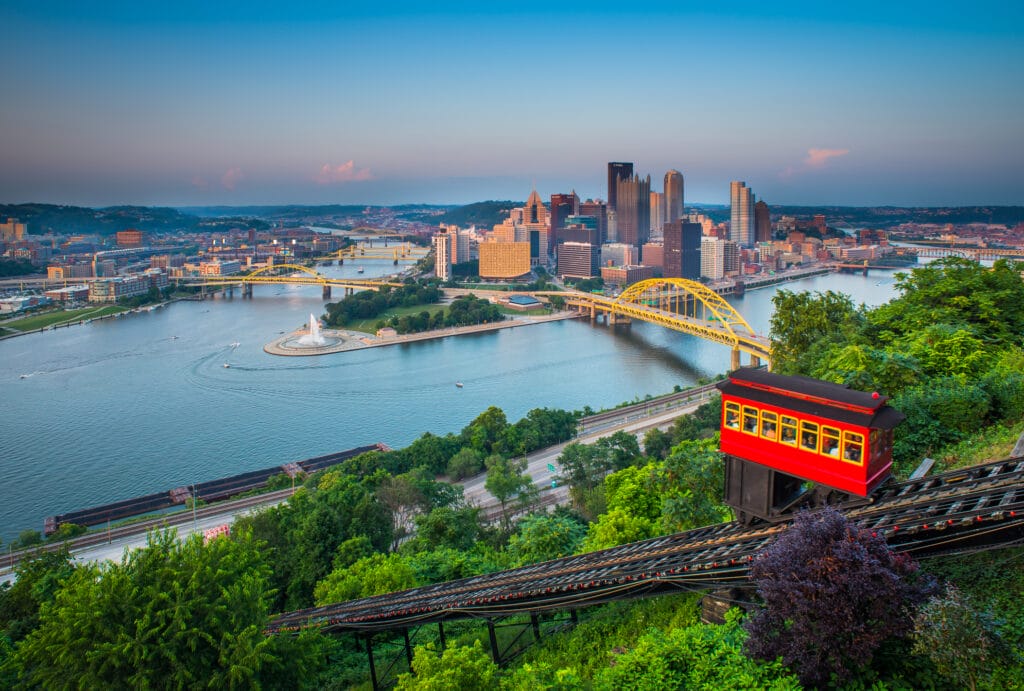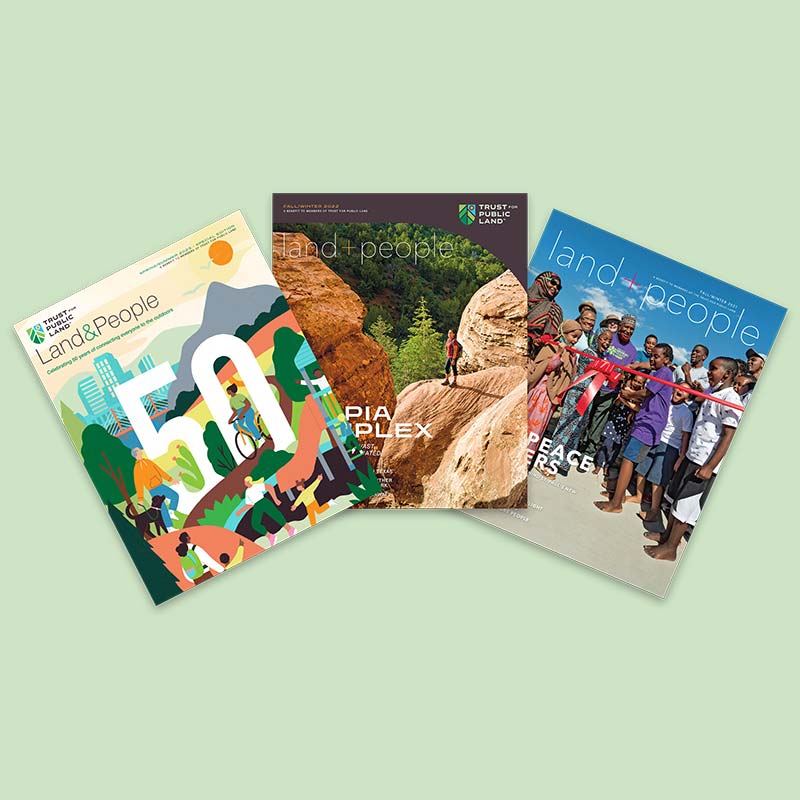Across the United States, communities are embracing the power of the great outdoors to revive or bolster their economies and attract residents. This is especially true for rural towns and urban cities where once-prevailing agricultural or industrial industries have declined. The transitions are gradual and complex, unfolding in former farming communities, manufacturing centers, and mining hubs. Trust for Public Land has partnered with many such communities in recent years, helping to install mountain bike trails, convert defunct railways to multiuse paths, buy and create town-owned community forests, and reclaim brownfields for new green space.
It’s a virtuous cycle: towns that invest in outdoor recreation attract new businesses which, in turn, attract an active workforce that desires easy access to bike trails and playgrounds, forests, and lakes. Residents have an outlet for exercise and that all-important, but sometimes elusive, immersion in nature. Studies show that time spent outdoors, especially when surrounded by trees and plants, confers all kinds of health benefits, from reduced blood pressure and stress hormones to improved mood and concentration. Thriving businesses, happy and healthy residents, and plenty of green space help communities boost and sustain overall quality of life. It’s a process that’s not only good for townspeople’s mental and physical health. It’s also good for a town’s bottom line.
The U.S. Bureau of Economic Analysis releases data each year measuring the impact of outdoor recreation on the American economy. In 2021, the most recent year for which statistics are available, the recreation economy accounted for 1.9 percent, or $454 billion, of the current-dollar gross domestic product for the nation. At the state level, value added for outdoor recreation as a share of state GDP ranged from 4.8 percent in Hawaii to 1.3 percent in New York and Connecticut.
From Florida to Oregon, we are training our sights on places committed to the potential of ecotourism, outdoor recreation, or simply a new park or two.
Despite the importance and popularity of our forests, they face unprecedented threats. Take action now and urge Congress to protect our country’s forests by signing our petition today!
Evolving from Agriculture
In Florida, where the recreation economy ranks 6th in the country with 3.3 percent of the state GDP, TPL has been working to bring the proposed 420-mile Florida Gulf Coast Trail to fruition. Passing through eight counties, the trail, when completed, will stretch roughly from Tampa to Naples. Decades ago, the entire region was dominated by agriculture, but farms have given way to suburbs. While sections of the trail already exist, many gaps remain.
Trust for Public Land is overseeing a regional effort with public and private partners to complete the trail and connect communities along the corridor. One city that is already reaping the benefits of the Florida Gulf Coast Trail is Dunedin, a waterfront community just west of Tampa. There, the so-called Pinellas Trail, which connects to the Florida Gulf Coast Trail, has energized the downtown, with new restaurants such as the Black Pearl and new shops like Thistle Boutique and Gallery.

People riding bicycles on the Fred Marquis Pinellas Trail in downtown Dunedin, Florida. Photo: iStock
“In Dunedin, the downtown was struggling, with a number of vacancies, but now it’s rocking,” says Charles Hines, TPL’s Florida Gulf Coast Trail program director. “The downtown has really become a destination.” A nonprofit that promotes the city, called Visit Dunedin, trumpets the Pinellas Trail on its site, highlighting its paved miles stretching from Tarpon Springs to St. Petersburg and running, of course, through the “heart of downtown Dunedin.” The group also points out the “bars, dining, and shopping along the way,” adding that there are “even water fountains for you and your dog.”
About a third of the planned Florida Gulf Coast Trail—which includes the Legacy Trail—is finished. Hines is now working with groups like the Friends of The Legacy Trail to refine the route to take advantage of existing parks and agricultural open space. A former Sarasota County commissioner, Hines is confident the full Florida Gulf Coast Trail will eventually come together. “Trails are funny,” he says. “They are the one thing everyone agrees on. Whether you are an environmentalist or a developer or a business owner, a trail system is a great public amenity that provides many positive benefits to a community.”
Help us complete the Florida Gulf Coast Trail
From Timber to Trails in Southern Oregon
Trails are also a lynchpin of the future in Klamath Falls, Oregon. The city of 22,000 was once a thriving timber town, with dozens of lumber mills busy cutting fir and pine. The industry thrived until the 1990s, when changing forest policies and a severe earthquake took a toll on the town’s economic and built environments.
Trust for Public Land has since helped Klamath Falls divine a new future. Just 10 miles outside of town rises Spence Mountain, where a private landowner had allowed the community to create 50 miles of trails on 7,500 acres. “As it got more popular and people started using it, there was a conversation about what happens if this property changes hands—after all of the investment in trails,” recalls Kristin Kovalik, TPL’s Oregon program director.
Working with the Klamath Trails Alliance, TPL and other partners bought the property in 2022. Klamath County acquired the land, while the Klamath Trails Alliance, which built the trails on Spence Mountain, partners with the county to oversee development and maintenance of the trail network.
Protecting the Spence Mountain property breathed new life into the economy of Klamath Falls, while ensuring that local residents and far-flung visitors retain a healthy outlet. According to the Robert Wood Johnson Foundation, Klamath County had ranked last in Oregon for health outcomes in 2021.
Drew Honzel, who helped create the Klamath Trails Alliance, says Spence Mountain, with an elevation change of 1,700 feet, was well suited for mountain biking and hiking.
“We used to see all these people driving right past Klamath Falls from California headed to Bend and Oakridge,” he adds. But those recreation patterns are changing. A recent marketing study by Discover Klamath, the official tourism agency for Klamath County, found that Spence Mountain averaged 30,000 visits a year over the last three years. More than a third of those visits were by people who lived more than 50 miles away, and they contributed more than $1.8 million to the local economy.
Help more towns like Klamath Falls build their recreation economy.
If You Green It, They Will Come
Sometimes, a renewed focus on parks and green space centers on a desire to attract and retain residents, as well as guard against climate change. Such is the case in Pittsburgh, which lost more than half its population from 1950 to 1990—some 300,000 people. That was due to the collapse of manufacturing, in particular steel. Since then, the city has rebounded with the arrival and expansion of other industries, namely technology, health care, and education.

Pittsburgh, Pennsylvania, River, sunset, 2014. Photo: iStock
Now the city wants to make sure all of those employees and their families choose to stay, with new parks and green spaces among the key ingredients making Pittsburgh one of America’s most livable cities. Since 2005, The Economist’s Global Livability Ranking has designated Pittsburgh the most or second-most livable city in the United States for six years.

Jessica Turner, president of Outdoor Recreation Roundtable
Jessica Turner, president of the Outdoor Recreation Roundtable, the nation’s leading coalition of outdoor recreation organizations, says that Pittsburgh’s efforts were part of a larger movement in Pennsylvania. In late August, the state created an Office of Outdoor Recreation, with a budget of $422,000 a year. It was the 20th state in the nation to launch an agency devoted to outdoor recreation.
“Pennsylvania is interesting because it has traditionally been dependent on coal, gas, and oil,” says Turner, who attended Governor Josh Shapiro’s announcement of the new state agency. “But the state wants to get away from the boom and bust cycles and aims to be the number one recreation economy in the country. Pittsburgh, in particular, has done an amazing job of connecting people to the outdoors.”
Indeed, in the past two years, Pittsburgh has acquired nearly 1,000 acres of new parkland, including 300 acres added to a network of greenways, according to Rebecca Kiernan, a principal resilience planner in Pittsburgh’s Department of City Planning. The new green space will help control the flooding and landslides that have upended the city in recent years as climate change bears down. And it addresses the eyesores that had marred the city since the exodus of residents; the population has stabilized in the past decade. “Those properties—many along steep slopes— had been dump sites, vacant lots, and places the city had neglected for 40 years,” Kiernan says.
In 2020, Trust for Public Land provided the City of Pittsburgh and community partners with a grant to launch a pilot program for ecological restoration on a 183-acre site known as Hazelwood Greenway. TPL’s support enabled the partners to remove abandoned appliances and invasive species such as knotweed, as well as plant trees and improve access.
Doug Hattaway, TPL’s southeast regional conservation director, notes that communities are sometimes motivated initially by a desire for recreational opportunities and economic development. But the ripple effects of that can be even more serendipitous.
“If you give people a place where they can visit and exercise, they are going to use it,” he says. “Exercise is vitally important. We are creating safe routes to work, to play, and to shop while fostering a sense of community. If you are walking on a trail or in a park, you are more inclined to say hello than if you are driving in a car.”
Lisa W. Foderaro is a senior writer and researcher for Trust for Public Land. Previously, she was a reporter for the New York Times, where she covered parks and the environment.
Feeling Inspired?
All of these places—and many more—are protected thanks to Trust for Public Land supporters. Join us in our mission to bring the profound benefits of equitable access to the outdoors to millions of people across America.

Donate to become a member, and you’ll receive a subscription to Land&People magazine, our biannual publication featuring exclusive, inspiring stories about our work connecting everyone to the outdoors.

